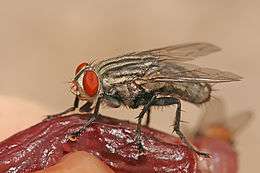Sarcophaga
Sarcophaga is a genus of true flies and the type genus of the flesh-fly family (Sarcophagidae).
| Sarcophaga | |
|---|---|
 | |
| Sarcophaga nodosa feeding on decaying meat | |
| Scientific classification | |
| Kingdom: | |
| Phylum: | |
| Class: | |
| Order: | |
| Family: | |
| Subfamily: | |
| Genus: | Sarcophaga |
| Type species | |
| Musca carnaria | |
This genus occurs essentially worldwide. These flies are generally well-sized and of a greyish color; like many of their relatives, the typical patterns are lengthwise darker stripes on the thorax and dark and light square dots on the abdomen. Many have conspicuous red compound eyes. These are set further apart in females than in males; the females are also larger on average. As typical for this family, it is almost impossible to tell the species apart from their outward appearance, and many can only be reliably identified by microscopic examination of the males' genitalia.
As the common name implies, their larvae typically feed on decaying meat. Some, however, rather eat the bacteria and other small organisms living on carrion. Many species have adapted to humans, and while they are usually nuisance pests, some are medically significant vectors of pathogens and bacteria. Sometimes, the larvae cause myiasis. Others are parasitoids of pest caterpillars and beneficial in forestry and orchards.
Well-known species are Sarcophaga africa, Sarcophaga bercaea, the grey flesh-fly Sarcophaga bullata, Sarcophaga carnaria, Sarcophaga crassipalpis, the friendly fly Sarcophaga aldrichi and the red-tailed flesh-fly Sarcophaga haemorrhoidalis.
Subgenera
The immense number of Sarcophaga species is divided among the following subgenera, some of which are occasionally considered (and may well be) distinct genera:
- Aethianella Zumpt, 1972
- Aethiopisca Rohdendorf, 1963
- Afrohelicobia Zumpt, 1972
- Afrothyrsocnema Rohdendorf, 1963
- Alisarcophagaa Fan & Chen, 1981
- Amharomyia Verves, 1984
- Anthostilophalla Lehrer, 1993
- Asceloctella Enderlein, 1928
- Asiopierretia Rohdendorf, 1963
- Australopierretia Verves, 1987
- Baliisca Verves, 1980
- Baranovisca Lopes, 1985
- Batissophalla Rohdendorf, 1963
- Bellieriomima Rohdendorf, 1937
- Bercaea (Robineau-Desvoidy, 1902)
- Bercaeopsis Townsend, 1917
- Beziella Enderlein, 1937
- Bilenemyia Verves, 1989
- Boettcheria Rohdendorf, 1937
- Brasia Strand, 1932
- Caledonia
- Callostuckenbergia
- Camerounisca
- Cercosarcophaga
- Chaetophalla
- Chrysosarcophaga
- Curranisca
- Curtophalla
- Cyclophalla
- Danbeckia
- Casyschloctis
- Dinemomyia
- Diplonophalla
- Discachaeta Enderlein, 1928
- Colichophalla
- Drakensbergiana
- Durbanella
- Dysparaphalla
- Fengia
- Fergusonimyia
- Fijimyia
- Hadroxena[2]
- Hardyella
- Harpagophalla
- Harpagophalloides
- Helicophagella Enderlein, 1928
- Heteronychia Brauer & Bergenstamm, 1889
- Hoa
- Horisca
- Hosarcophaga
- Hyperacanthisca
- Ihosyia
- Iranihindia
- Johnsonimima
- Johnstonimyia
- Kalshovenella
- Kanoa
- Kanomyia
- Kozlovea
- Kramerea
- Krameromyia Verves, 1982
- Leucomyia
- Lipoptilocnema
- Lioplacella
- Lioproctia
- Liopygia Enderlein, 1928
- Liosarcophaga Enderlein, 1928
- Macabiella
- Malliophala
- Mandalania
- Mauritiella
- Mehria Enderlein, 1928
- Mimarhopocnemis
- Mindanaoa
- Mufindia
- Myorhina Robineau-Desvoidy, 1830
- Neobellieria
- Neosarcophaga
- Nesbittia
- Nigerimyia
- Nihonea
- Notoecus
- Nudicerca
- Nuzzaciella
- Nyikamyia
- Pandelleana
- Pandelleisca Rohdendorf, 1937
- Paraethiopisca
- Parasarcophaga Johnston & Tiegs, 1921
- Petuniophalla
- Phalacrodiscus
- Phallantha
- Phallanthisca
- Phallocheira
- Phallonychia
- Phallosphaera
- Phytosarcophaga
- Poecilometopa
- Poeciphaoides
- Prionophalla
- Pseudaethiopisca
- Pseudothyrsocnema
- Pterolobomyia
- Pterophalla
- Pterosarcophaga
- Robineauella Enderlein, 1928
- Rohdendorfisca
- Rosellea Rohdendorf, 1937
- Sabiella
- Sarcophaga
- Sarcorohdendorfia
- Sarcosolomonia
- Sarcotachinella Townsend, 1892
- Scotathyrsia
- Seniorwhithea
- Sinonipponia
- Sisyhelicobia
- Stackelbergeola
- Takanoa
- Takaraia
- Taylorimyia
- Thyrsocnema Enderlein, 1928
- Tolucamyia
- Torgopampa
- Transvaalomyia
- Tuberomembrana
- Uroxanthisca
- Varirosellea Xue, 1979
- Wohlfahrtiopsis
- Xanthopterisca
- Ziminisca
- Zombanella
- Zumptiopsis
- Zumptisca
References
- J. M. Aldrich (2009) [Originally published 1916]. Sarcophaga and Allies in North America. BiblioBazaar. ISBN 978-1-115-40881-3. Read the original edition of Sarcophaga and Allies in North America at Google Books.
- Whitmore, Daniel; Buenaventura, Eliana; Pape, Thomas (2018). "Odd, outsized, and obscure: Sarcophaga (Hadroxena) karakoncolos sp. n. (Diptera: Sarcophagidae) from Turkey". Zootaxa. Auckland, New Zealand: Magnolia Press. 4422 (3). doi:10.11646/zootaxa.4422.3.4. ISSN 1175-5334. PMID 30313492.
Further reading
- Natori, S (2010). "Molecules participating in insect immunity of Sarcophaga peregrina". Proceedings of the Japan Academy, Series B. 86 (10): 927–38. doi:10.2183/pjab.86.927. PMC 3035055. PMID 21157125.
- Sousa, JR; Esposito, MC; Carvalho Filho, FS (2011). "Composition, abundance and richness of Sarcophagidae (Diptera: Oestroidea) in forests and forest gaps with different vegetation cover". Neotropical Entomology. 40 (1): 20–27. doi:10.1590/S1519-566X2011000100003. PMID 21437478.
External links

